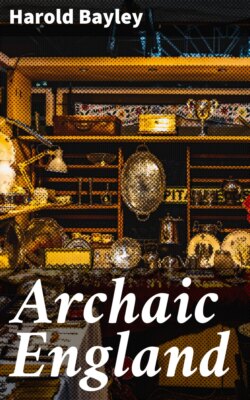Читать книгу Archaic England - Harold Bayley - Страница 12
На сайте Литреса книга снята с продажи.
Footnote
ОглавлениеTable of Contents
[86] Taylor, Rev. T., The Celtic Christianity of Cornwall, p. 27.
[87] Morris-Jones, Sir J., Y. Cymmrodor, xxvii., p. 240.
[88] Margoliouth, M., The Jews in Great Britain, p. 33.
[89] As bearing upon this statement I reprint in the Appendix to the present volume a very remarkable extract from Britain and the Gael (Wm. Beal), 1860.
[90] Wilkes, Anna, Ireland: Ur of the Chaldees, p. 6.
[91] Introduction to Malory’s Morte d’Arthur (Everyman’s Library).
[92] Plutarch, De Defectu Oraculorum, xvii.
[93] Eckenstein, L., Comparative Studies in Nursery Rhymes, p. 70.
[94] Clodd, E., Tom Tit Tot, p. 131.
[95] Mackenzie, D. A., Myths of Crete and Pre-Hellenic Europe, p. 326.
[96] Cf. Poste, B., Britannic Researches, p. 220.
[97] Y Cymmrodor, xxviii.
[98] Triad 4.
[99] “The notion that the Albanian is a mere mixture of Greek and Turkish has long been superseded by the conviction that though mixed it is essentially a separate language. The doctrine also that it is of recent introduction into Europe has been similarly abandoned. There is every reason for believing that as Thunmann suggested, it was, at dawn of history, spoken in the countries where it is spoken at the present moment.”—Latham, R. G., Varieties of Man, p. 552.
[100] Rhys, J., Celtic Britain.
[101] The same root may be behind deruish or dervish.
[102] Gordon, E. O., Prehistoric London, p. 127.
[103] Virgil, Æneid, 79, 80, 81.
[104] Cornish Feasts and Folklore, p. 119.
[105] Malory, viii.
[106] I question the current supposition that this is a corruption of chy an woon or “house on the hill”.
[107] Beal, W., Britain and the Gael, p. 22.
[108] Herodotus, 11, 52.
[109] Johnston, J. B., Place-names of England and Wales, p. 413.
[110] Burrows, R. M., The Discoveries in Crete, p. 11.
[111] Hastings (Ward Lock & Co.), p. 63.
[112] xxvii. 12.
[113] Sepulchres of Ancient Etruria, p. 9.
[114] From mercari, to trade (Skeat).
[115] Jonnock is probably cognate with yankee, which was in old times used in the New England States as an adjective meaning “excellent,” “first-class”. Thus, a “yankee” horse would be a first-class horse, just as we talk of English beef and other things English, meaning that they are the best. Another explanation of yankee is that when the Pilgrim Fathers landed at Plymouth Rock, near Massachusetts Bay, in 1620, they were met on the shore by native Indians who called them “Yangees”—meaning “white man”—and the term was finally completed into “Yankees”.
[116] Taylor, Rev. R., Diegesis, p. 158.
[117] The remarkable serpentine, shell-mosaiked shrine, known as Margate Grotto, is discussed in chap. xiii.
[118] i., 367.
[119] Odyssey, Book IV.
[120] Cf. Smith, G., Religion of Ancient Britain, p. 65.
[121] Myths of Crete and Prehistoric Europe, p. 239.
[122] Rydberg, V., Teutonic Mythology, pp. 22-36.
[123] Odyssey, Book I.
[124] Ibid., Book III.
[125] The Myth of Br. Islands, p. 324.
[126] The current idea that London was Llyn din, the Lake town, has been knocked on the head since it has been “proved that the lake which was described so picturesquely by J. R. Green did not exist”. Cf. Rice Holmes, Ancient Britain, p. 704.
[127] Londres, the Gaulish form of London, implies that the radical was Lon—and perhaps further, that London was a holy enclosure dun or derry where luna, the moon, was worshipped. There is a persistent tradition that St. Paul’s, standing on the summit of Ludgate Hill or dun, occupies the site of a more ancient shrine dedicated to Diana, i.e., Luna.
[128] This name will subsequently be traced to Cres, the son of Jupiter, to whom the Cretans assigned their origin.
[129] Wright, T., Essays on Archæological Subjects, vol. i., p. 273.
[130] Wright, T., Essays on Archæological Subjects, vol. i., p. 283.
[131] In Albany the memory of “the gudeman” lingered until late, and according to Scott: “In many parishes of Scotland there was suffered to exist a certain portion of land, called the gudeman’s croft, which was never ploughed or cultivated, but suffered to remain waste, like the Temenos of a pagan temple. Though it was not expressly avowed, no one doubted that ‘the goodman’s croft’ was set apart for some evil being; in fact, that it was the portion of the arch-fiend himself, whom our ancestors distinguished by a name which, while it was generally understood, could not, it was supposed, be offensive to the stern inhabitant of the regions of despair. This was so general a custom that the Church published an ordinance against it as an impious and blasphemous usage.
“This singular custom sunk before the efforts of the clergy in the seventeenth century; but there must still be many alive who, in childhood, have been taught to look with wonder on knolls and patches of ground left uncultivated, because, whenever a ploughshare entered the soil, the elementary spirits were supposed to testify their displeasure by storm and thunder,”
Demonology and Witchcraft.
[132] These Sources of Life or vessels of Almighty Power were described as Crown, Wisdom, Prudence, Magnificence, Severity, Beauty, Victory, Glory, Foundation, Empire. Cf. King, C. W., The Gnostics and their Remains, p. 34.
[133] Johnston, Rev. J. B., Place-names of England and Wales.
[134] “The origin of the name is quite unknown to history.... Possibly because so many dogs were drowned in the Thames here.”—Johnston, Rev. J. B., Place-names of England, p. 321.
[135] Walsh, R., An Essay on Ancient Coins, Medals, and Gems, p. 58.
[136] Rhys, Sir J., Celtic Heathendom, pp. 14-16.
[137] British children still cross their forefingers as a sign of treus, pax, or fainits.
[138] Britannia Antiquissima, p. 4.
[139] Cf. Thomas, J. J., Britannia Antiquissima, pp. 84, 85.
